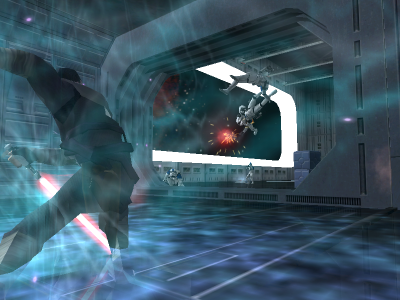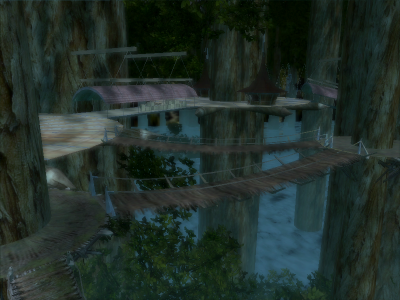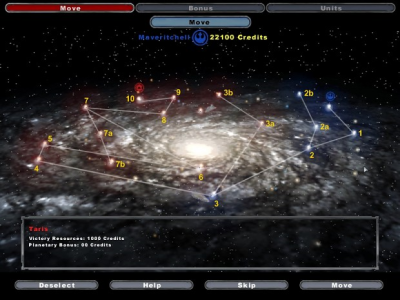

Dark
Times mod
What I've worked on:
What I've worked on:
•Several
dozen unit classes
•Fifteen maps
•Four scripted singleplayer/multiplayer map modes
•Scripted sixteen-map campaign
•Management of testing and contributing creators
•Fifteen maps
•Four scripted singleplayer/multiplayer map modes
•Scripted sixteen-map campaign
•Management of testing and contributing creators
This mod -
the "Dark Times" mod - was the largest-scope mod I'd put together for
the game Star Wars
Battlefront II. I'd
previously worked on a mod with a larger scale (the "Conversion Pack"
mod), but this mod is one I'm more proud of, since it represents some
truly unique creations in the Battlefront
II modding scene.
I
started this mod as a really, really basic concept. I was somewhat
enamored, at the time, of the experience that brawlers (e.g. God of War) provided - the
fluidity of interaction and the feeling of power that they lend the
player. I played around with mirroring the concept inside Battlefront II with
the intent of putting together a single-player one-versus-many
experience. The full depth of the target wasn't something I thought I
could realize, but after a little experimenting, I had come up with
something that I felt was pretty close.
At some point, though, I decided that this would be better applied to a whole slew of "hero" characters in the game, though. I think (and thought) that Battlefront II's hero concept was a good one, in terms of rewarding the player with a powerful upgrade, but the experience with the upgrade left a little to be desired. To the end of fixing that, I decided to apply the changes I'd just made to the base hero system - and that became the core of the "Dark Times" mod.

The
first version of the mod was relatively simple. I focused heavily on
the core of crafting these heroes in the style of brawlers, and I used
the recently-released Star Wars brawler The Force Unleashed
as inspiration. I designed a mode that was to be the primary showcase
for these changes; "wave mode," a mode in which the character was
pitted against steadily-increasing hordes of enemies, culmanating in
"boss" battles that would represent completion of the mode.
I made various other changes as well - ancillary changes, things that were added simply to give me the opportunity to try them out in (what I now anticipated this being) a popular mod.
I released this first version of the mod, and it was fairly successful. For having been released so late in the game's lifespan, it received a fairly large amount of attention, despite its relatively small additions to the game.
A while later, after wrapping up a separate Battlefront II project, I started looking for the opportunity to try out a few map concepts I'd thought up in the interim. Usually, I'd make these as standalone map releases, but I had three or four just sticking in my craw, and I couldn't decide which of them I wanted to try the most. So I decided to do all of them, which meant that I'd be putting together a map pack or a full mod.
In completing the interim project, I'd also been ruminating on some small additions I'd liked to have made to the "Dark Times" project, but I didn't want to revisit the mod simply to make some small changes. Eventually, the concepts for the map pack and the desire for the Dark Times changes met up in my head and decided to work together, and so I set out to simply make a large update - a version 2.0 - of the Dark Times mod.

I knew that, for the second version/update, I would have to expand, or
at least redefine, the scope somewhat. I felt that the focus on
brawling was a good one, and a great concept in actual play, but it had
been successful in no small part due to its direct association with the
Force Unleashed title.
Since I wouldn't be mining that for inspiration this time around (the
map concepts I had precluded that), I looked back at the original mod
and parsed what it really did for the player.
My conclusion was this: The game Battlefront II had been released several years in the past (five, at that time), and most of the consumers of mods were using them solely in a single-player fashion. What my original Dark Times mod did, more than anything else, was service that market by providing a mod that didn't require the player to be playing in a multiplayer setting - its focus was on the individual having a good experience more than anything. So that was the concept I ran with in the second version of "Dark Times."
In that vein, I focused heavily on the "maps" side of the changes. In my own experience, the mods I appreciated most - the ones I felt added the most to my play experience - were the ones that included new things for me to explore. I recruited several collaborators for the project; all people who had a pretty decent track record of creating fun new maps. Each designer created a map concept (and, of course, I worked on the several aforementioned concepts of my own) and delivered it to me, where I would reflavor the map (tweak the environment, add/remove props, polish, balance, etc.) to fit the general beats of the campaign I was writing out.
That campaign would be the second major feature of the new mod. The most standout singleplayer mod content in the game - in my opinion - had been that content that focused on delivering a scripted experience to the player. One big reason for this was probably because it was less common and consequently more novel (script work had a higher barrier to entry than just using the tools to make a map or a unit). However, it also almost always ensured a unique experience in a game where so much of the gameplay was determined by the variable interactions between individual units and not anything structural - there was little fundamental change in goals from map to map; it was the player choice that really made for most of the differences in experience in the stock game.

And that was all to say that I felt it important to provide an
extensive scripted experience to the player. Battlefront II actually
already had a singleplayer campaign built in to the stock game, and
while an entirely linear experience, it was an enjoyable one. For my
singleplayer campaign, I decided to leverage a different tool - Battlefront II's
"Galactic Conquest" interface.
The "Galactic Conquest" section of the game is an odd one - it's a unique feature that, at times, feels very secondary to the design of the game. It's a nonlinear, turn-based, player-versus-AI challenge wrapped in almost a strategy game's clothing. A map of interconnected points is the setting, and players move from point-to-point on their turns and attempt to conquer enemy-controlled points (which is facilitated by jumping in to the standard "conquest" mode of the game). There's a progression-based economy to the scenario as well; allowing for the player to purchase upgrades as he progresses through the scenario.
All of that makes for a great opportunity to try out a different type of campaign. I used this schema to plan out a campaign with a linear structure at its core (e.g. "progress down the road in this order") with the opportunity to jump off the rails at various points and pursue optional side-stories. These all worked in conjunction with the economy structure of Galactic Conquest to provide rewards for exploring and incentive for progression.
As before, I used the release of this mod to try out several different tiny experiments and see how they'd operate in real play. They ranged from pretty successful (the fully-realized "Space" mode) to marginally forgettable (the standard "VIP" mode). The mod as a whole, though, was a great success - it's easily my most popular work in the Battlefront II community outside of the much-earlier-released Conversion Pack (in which I was not the sole driving force).
This mod can be downloaded at:
ModDB
Gamefront
At some point, though, I decided that this would be better applied to a whole slew of "hero" characters in the game, though. I think (and thought) that Battlefront II's hero concept was a good one, in terms of rewarding the player with a powerful upgrade, but the experience with the upgrade left a little to be desired. To the end of fixing that, I decided to apply the changes I'd just made to the base hero system - and that became the core of the "Dark Times" mod.

I made various other changes as well - ancillary changes, things that were added simply to give me the opportunity to try them out in (what I now anticipated this being) a popular mod.
I released this first version of the mod, and it was fairly successful. For having been released so late in the game's lifespan, it received a fairly large amount of attention, despite its relatively small additions to the game.
A while later, after wrapping up a separate Battlefront II project, I started looking for the opportunity to try out a few map concepts I'd thought up in the interim. Usually, I'd make these as standalone map releases, but I had three or four just sticking in my craw, and I couldn't decide which of them I wanted to try the most. So I decided to do all of them, which meant that I'd be putting together a map pack or a full mod.
In completing the interim project, I'd also been ruminating on some small additions I'd liked to have made to the "Dark Times" project, but I didn't want to revisit the mod simply to make some small changes. Eventually, the concepts for the map pack and the desire for the Dark Times changes met up in my head and decided to work together, and so I set out to simply make a large update - a version 2.0 - of the Dark Times mod.

My conclusion was this: The game Battlefront II had been released several years in the past (five, at that time), and most of the consumers of mods were using them solely in a single-player fashion. What my original Dark Times mod did, more than anything else, was service that market by providing a mod that didn't require the player to be playing in a multiplayer setting - its focus was on the individual having a good experience more than anything. So that was the concept I ran with in the second version of "Dark Times."
In that vein, I focused heavily on the "maps" side of the changes. In my own experience, the mods I appreciated most - the ones I felt added the most to my play experience - were the ones that included new things for me to explore. I recruited several collaborators for the project; all people who had a pretty decent track record of creating fun new maps. Each designer created a map concept (and, of course, I worked on the several aforementioned concepts of my own) and delivered it to me, where I would reflavor the map (tweak the environment, add/remove props, polish, balance, etc.) to fit the general beats of the campaign I was writing out.
That campaign would be the second major feature of the new mod. The most standout singleplayer mod content in the game - in my opinion - had been that content that focused on delivering a scripted experience to the player. One big reason for this was probably because it was less common and consequently more novel (script work had a higher barrier to entry than just using the tools to make a map or a unit). However, it also almost always ensured a unique experience in a game where so much of the gameplay was determined by the variable interactions between individual units and not anything structural - there was little fundamental change in goals from map to map; it was the player choice that really made for most of the differences in experience in the stock game.

The "Galactic Conquest" section of the game is an odd one - it's a unique feature that, at times, feels very secondary to the design of the game. It's a nonlinear, turn-based, player-versus-AI challenge wrapped in almost a strategy game's clothing. A map of interconnected points is the setting, and players move from point-to-point on their turns and attempt to conquer enemy-controlled points (which is facilitated by jumping in to the standard "conquest" mode of the game). There's a progression-based economy to the scenario as well; allowing for the player to purchase upgrades as he progresses through the scenario.
All of that makes for a great opportunity to try out a different type of campaign. I used this schema to plan out a campaign with a linear structure at its core (e.g. "progress down the road in this order") with the opportunity to jump off the rails at various points and pursue optional side-stories. These all worked in conjunction with the economy structure of Galactic Conquest to provide rewards for exploring and incentive for progression.
As before, I used the release of this mod to try out several different tiny experiments and see how they'd operate in real play. They ranged from pretty successful (the fully-realized "Space" mode) to marginally forgettable (the standard "VIP" mode). The mod as a whole, though, was a great success - it's easily my most popular work in the Battlefront II community outside of the much-earlier-released Conversion Pack (in which I was not the sole driving force).
This mod can be downloaded at:
ModDB
Gamefront